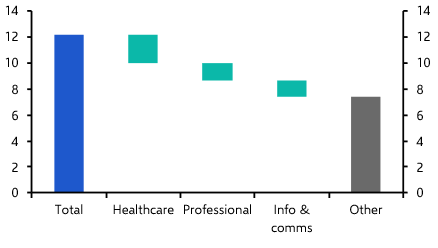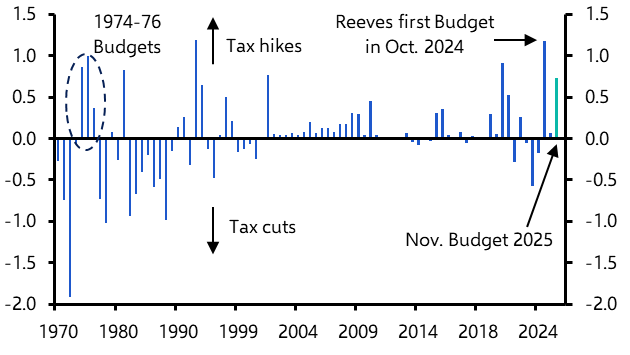We recently held an online client briefing (watch a recording here) to discuss the US economic outlook. Here we answer some of the most frequently asked questions, including around AI's role in shaping the outlook.
Our US Economic Outlook argues that the US is set for a period of above-potential GDP growth thanks to the AI-related investment boom, that inflation is likely to remain above the Fed’s 2% target, but that the Fed will nonetheless cut interest rates a few more times. That report is the key place to look for a discussion of our thinking. Here, we answer some of the most interesting questions we received during the Drop-In.
Are AI-related investments helping to offset the slowdown in growth caused by tariffs and other factors? The relationship between AI-related investment and GDP growth is not straightforward. Unlike during the dot.com boom, nearly all computer hardware is now imported, meaning the boost to GDP from increased hardware investment is offset by higher imports. That said, related investments in domestically-produced software and research & development, as well as structures investment in data centres, are helping to lift GDP growth and offset an (albeit smaller-than-expected) tariff-induced drag on the economy.
Given the recent MIT paper on the lack of success of corporate AI projects, how certain are you of stronger growth thesis? We’re not particularly alarmed by the finding that only 5% of AI pilot projects have generated material P&L outcomes so far. For a start, there are many examples of new technologies that appeared to result in little payoff to begin with. The internet offers several, particularly for retailers who initially had to fund a whole new set of infrastructure to support online retailing, while still maintaining the same physical presence. What’s more, one perhaps underappreciated point when it comes to generative AI is that its sudden, widespread availability has made it much easier for many firms to experiment. The MIT report showed that 80% of firms surveyed had already investigated using LLMs, a strikingly high share for a technology that only appeared a few years ago. And while the report highlights that only two out of eight major sectors have so far experienced a meaningful change from the use of AI, it is arguably still impressive that 25% of major sectors are experiencing such change at this early stage in the technology.
What is the balance in AI between its benefits to productivity and the risks to the labour market? Given findings like those noted above, we suspect that AI is behind only some of the recent cyclical labour market weakness. But productivity and risks to the labour market are clearly interlinked. The more that firms are able to use AI to carry out tasks that required human input, the more likely it is that they will be able to get by with fewer employees. This is the same with any new technology, however, and the overriding theme throughout past adoptions of new general purpose technologies is that the resulting boost to productivity lifts overall economic activity, which eventually raises labour demand elsewhere in the economy. While we still think that general framework will hold true this time, there is a risk that the speed of the technological advance could result in greater labour market disruption during the adoption phase than we are currently forecasting.
What is your take on the flurry of cross investments between the big AI players? Vertical and horizontal integration is a natural part of economic development, and it makes sense that established tech companies might want to invest in smaller, higher risk companies rather than take all that riskier innovation in house. But we should be conscious of the potential negative consequences further down the line. For example, to the extent that GPU suppliers are making big investments in AI start-ups in the hope of raising demand for their product in the near term, then that also increases the likelihood that there could eventually be an excess supply of GPUs and computer power. That would in turn weigh on the ability of those firms to turn a profit, and raise the likelihood that the sector as a whole might eventually have to cut back on capex dramatically.
What are your thoughts on an AI bubble and the potential bursting of any bubble? As our 2023 Spotlight report on AI, Economies and Markets highlighted, new general purpose technologies have almost always coincided with some sort of financial market bubble, as investors sought to capitalise on the gains before the true extent of the benefits was certain. This time is unlikely to be different, but the reassuring feature for now is that, if it is a bubble, then it is an equity-funded bubble in a productive asset rather than a debt-funded bubble in an unproductive asset. This has two key benefits: equity funding reduces the risk of a sharp deleveraging after the bubble bursts, avoiding a severe economic downturn like the 2000s real estate crash. Investment in a productive asset also allows households and corporates to continue benefiting from cheap access to the technology after any potential bust, which should support productivity, as the computer hardware surge of the late 1990s did. For now, the economy is still balanced enough that any bursting of an AI bubble should trigger only a shallow recession, as tech-related investment and wealth effects from the popping equity market reverse. That conclusion, however, could change 5–10 years down the line if tech-related investment ends up propping up the economy a lot more than it does today.
What do your views on GDP and inflation mean for the Fed? We think that an AI-induced resurgence in productivity will keep the economy growing at pace over the next couple of years. This will offset any drag from the immigration crackdown which, by weighing on labour supply and demand in equal parts, will barely raise the unemployment rate. And while tariffs are now likely to have only a muted impact, sticky services inflation will keep the Fed’s preferred PCE measure of inflation above target for the foreseeable future. Taken together, we think the Fed will lower its funds rate by an additional 75bp over the next 12 months down to a low of 3.25%–3.50%, which compares to the latest market-implied trough of about 3%. This would leave rates roughly in line with where we believe “neutral” is for now, although we see this rising over the coming years as the boost to productivity from AI broadens. (See here.)
Should we fear a loss of Fed independence? While it’s something we should keep an eye on, we don’t think that Trump’s attempts to pressure the Fed to cut rates more aggressively have had much of an impact on the FOMC’s decisions so far. Perhaps he has emboldened dovish FOMC members such as Christopher Waller and Michelle Bowman to advocate for even lower rates, but on the flip side he may have also galvanised other FOMC members to push-back and be more stubbornly hawkish, while Stephen Miran’s views are probably too far apart from other FOMC members for him to be able to build consensus for larger rate cuts. Meanwhile, Trump’s attempts to fire Lisa Cook have been stayed by the courts; the US Supreme Court has recently ruled that Cook can stay on as Federal Reserve governor while the mortgage fraud allegations against her are properly investigated. As we discuss in an Update, it remains unlikely that Trump will be able to capture a majority of the 12-person FOMC voting committee, and any pick for Federal Reserve Chair would need to be reasonable enough to get through a Senate confirmation process.
What do you think of the discussion about the Feds third mandate and might a return to QE lower long-term rates? We think fears that the Fed’s third mandate – to promote “moderate long-term interest rates” – will be used to justify a return to interventionist monetary policy, such as QE, are somewhat overblown. As Powell emphasised in September, the Fed views this mandate as something that falls out of achieving its two core objectives: “stable prices” and “maximum employment”. Even if the Fed were to engage in QE as a form of long-term yield curve control, as it did post-WWII, any success would likely weaken the dollar, raising inflation and potentially fed funds rate expectations, thereby offsetting some of the downward pressure on long rates.





